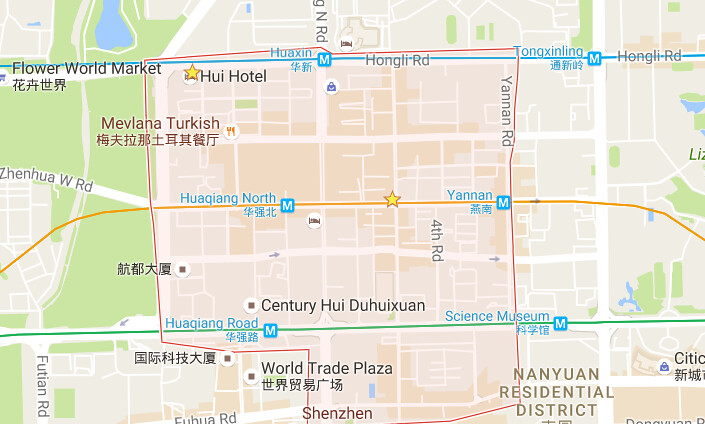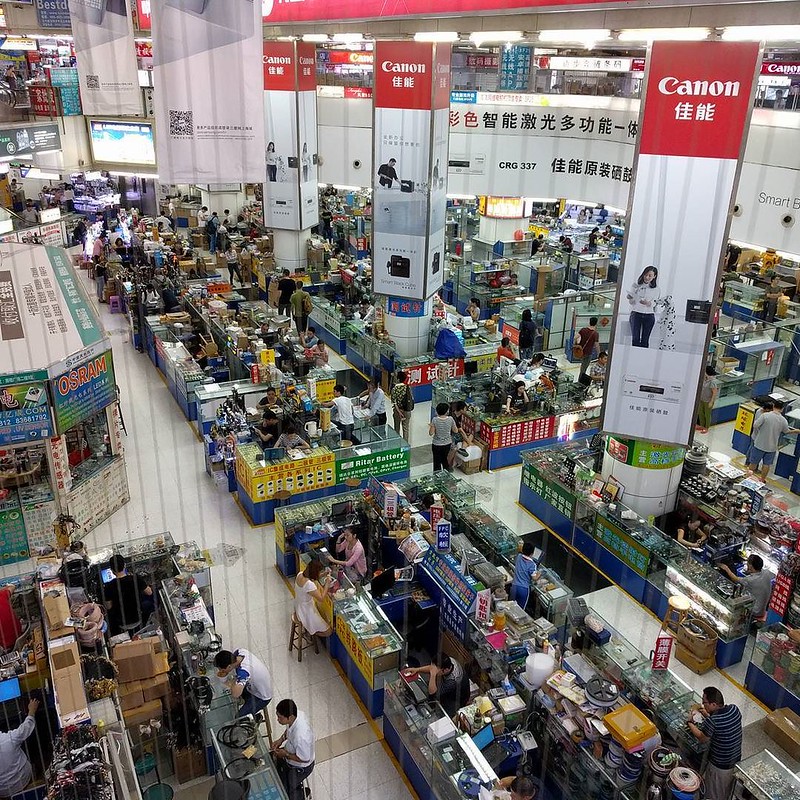This and the following blog posts aims to document a trip to Shenzhen, to the cradle of things. To read all blog posts in the series, click on the viewsource tag.
Please note: These are quick notes typed up while traveling. Apologies for any typos, missing links, etc.
Today is market day. This is exciting!
First impressions: The [Huaqiangbei electronics market] is overwhelming, and hard to navigate due to its sheer size.
 This is the outline of the market. A good chunk of it is for electronics.
This is the outline of the market. A good chunk of it is for electronics.
Huaqiangbei isn’t just big, though. It’s also incredibly dense. You’ll find floors upon floors of sometimes tiny, crammed market stalls selling anything from full computers or robots down to individual buttons, displays, or even just cables.
 This is just one of many floors, in one of many buildings.
This is just one of many floors, in one of many buildings.
This extends over many, many floors in several city blocks. The map above shows the outlines of the last buildings involved in the market, but there’s a clear focus on the center, the area between the orange and green metro lines, and a little north of it.
///
No filming without a permit. Both of our teams have cameras, and both get approached by security within seconds of entering the building. Partially this seems to be to avoid footage of counterfeit goods: The government wants to clean up the market, and its image. Several people reference a British TV crew that came in under false pretense of shooting positive coverage and using the material for an exposé of fake goods; now security is a little on edge.
We weren’t expecting this and start work on getting a permit on short notice.
///
While our translater reaches out to his network to reach the building management, we go explore the main building. The ground floor is components: Buttons, resistors, cables. Tons of chargers and USB cables. As you move upstairs, you move downstream: The higher you get, the higher the abstraction level seems to get: It gets a little more consumer grade, finished products replace the building parts of downstairs.
It feels a little like you could work your way up the building and as you start picking up stuff you assemble them; by the time you get to the top floor, you’d have a finished phone in hand.
///
This place is huge. It’s several blocks, with a core of maybe 3×3 city blocks. All buildings are 5 floors at least, most are much higher.
///
More and more electronics and goods are replaced by smartphones. If software is eating the world, smartphones are eating the hardware world. (Which of course means that software is eating the hardware world, too.)
From a pure tourist point of view, this is a bit of a bummer: Smartphones aren’t as fun to explore as other, more crazy creations you might have found here 5-10 years ago.
///
Most buildings and most floors are highly specialized. For example, there’s a whole building for security. When you enter you’ll find thousands of cameras staring at you.
///
You come to the market to buy prototyping materials and samples, or to buy bulk. The former is acceptable because everybody knows that’s necessary to get to the latter. With every purchase or even conversations, the stall owner will hand out a business card to order more.
My favorite business card was this one:
///
The market is for components, be they cables or complex electronics. This isn’t a consumer market. Unless you really know what you’re doing, what you’re looking for, and how to assess quality, you need an interface.
Quality management is up to the buyer, not the manufacturer or seller (they might be the same person or company: each stall is a window into a whole supply chain of its own).
The same is true for ordering manufacturing: If you want a certain quality, make sure to order and check it. Hire someone to do it. All levels of quality can be done, it’s a question of how much you choose to invest.
///
Today’s haul: a giant (4″) 1 character LED display (22R MB /3 €). A fabric USB C cable (10 RMB, 1.50 €), a four-outlet USB charger (40 RMB / 6 €).
///
In the evening we head out for dinner at a Charme Restaurant, which offers a modern take on Cantonese. Over dinner we arrange more visits this week, to Maker World and HAX. The bike team pitches and explains their idea to the various new people in the group: It’s most definitively a conversation starter.
///
From David Li I learned about the history of the label “Made in Germany” (Wikipedia): “The label was originally introduced in Britain [in 1887] to mark foreign produce more obviously, as foreign manufactures had been falsely marking inferior goods with the marks of renowned British manufacturing companies and importing them into the United Kingdom. Most of these were found to be originating from Germany…” In other words, it was a consumer protection measure, a warning against inferior imported goods.
How wrong and outdated might our current conception of the quality of “Made in China” be? From what we’ve seen so far in Shenzhen, there is a lot of high-quality design work done locally. Plus, we know that the manufacturing can be done in all levels of quality. After all, cheap usb cables are made in Shenzhen, and so are iPhones.
What is “Made in China” going to mean in 5, 10, 50 years?
///
The Shenzhen market looks like a street market, but it’s a window into a gigantic global market.
These days I’m told a market stall is about USD 1K per month of rent per sqm in these markets. The stalls generate something to the tune of 3 million RMB (USD 430K) revenue per sqm.
In other words, it’s quite expensive to have a market stall here, but they have a tremendous ROI. This is serious business.
///
We learn quickly that in Shenzhen, making a product isn’t necesessarily about technology. Technology is a commodity. What do you want to make?
David summarizes: “Everything here [in the Shenzhen electronics market] is a component for your creation!”

